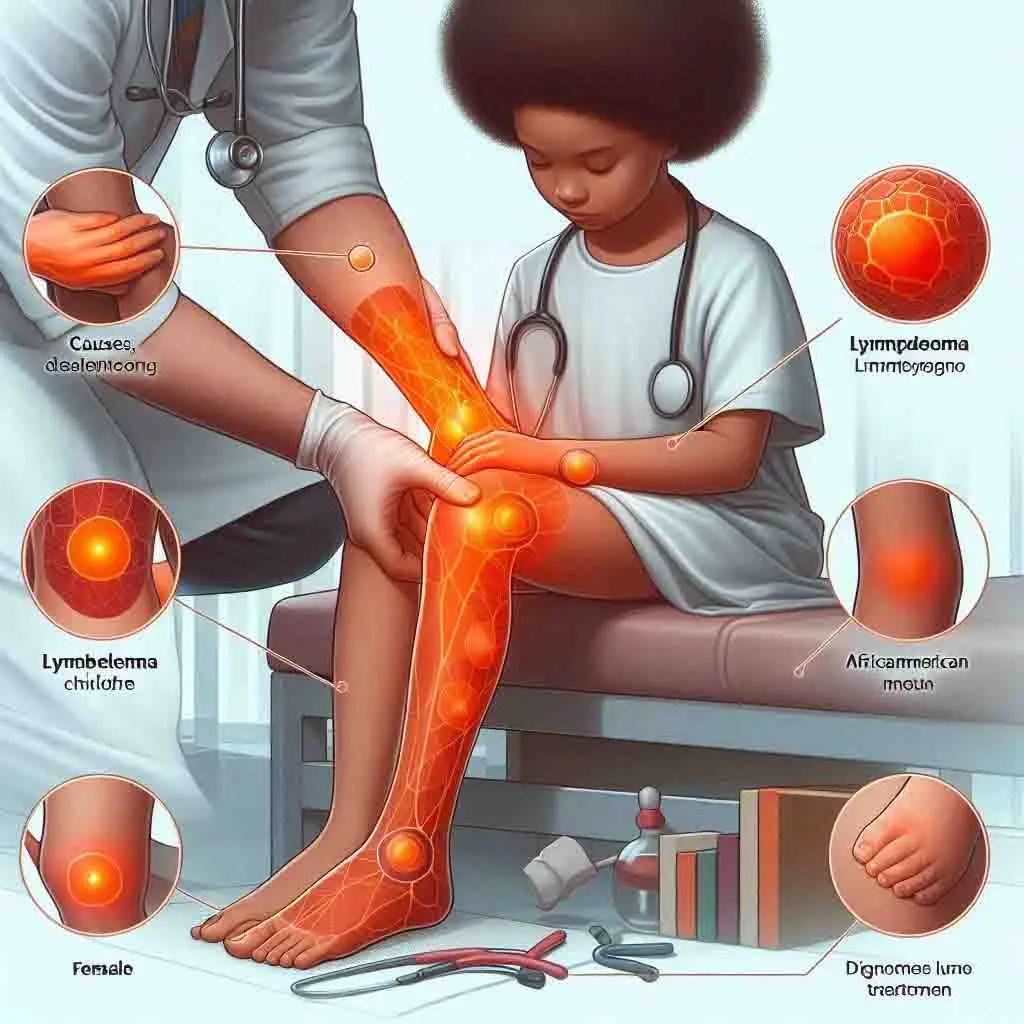Understanding Lymphedema in Children: Primary and Secondary Lymphedema
Lymphedema in children is a complex condition that affects the lymphatic system, leading to swelling and discomfort. This article aims to provide a comprehensive overview of lymphedema in pediatric patients, highlighting its types, symptoms, diagnosis, treatment options, and ways parents can support their children. Understanding both primary and secondary lymphedema is essential for effective management, ensuring children with lymphedema lead a healthy and active life.
What is Lymphedema in Children and How is it Diagnosed?
Lymphedema occurs when lymph fluid builds up in the body’s tissues due to a malfunction in the lymphatic system. In children, this condition can manifest in various ways, often leading to noticeable swelling in the arms or legs. Diagnosis of lymphedema in pediatric patients typically involves a thorough medical history and physical examination. Healthcare professionals assess the affected area for swelling and other signs, while also considering the child’s developmental milestones and any congenital conditions that may be contributing factors.
What are the Symptoms of Lymphedema in Pediatric Patients?
The symptoms of lymphedema in pediatric patients primarily include swelling in the affected limb, which can be noticeable and may lead to discomfort. Children with lymphedema may experience heaviness in the swollen area, restricted movement, and even skin changes such as thickening or hardening. In some cases, lymphedema may also be accompanied by recurrent infections like cellulitis due to compromised skin integrity. Recognizing these symptoms early is crucial for timely intervention and management.
How is Primary Lymphedema Diagnosed in Children?
Primary lymphedema in children is often diagnosed through a combination of clinical evaluation and imaging techniques. Healthcare providers typically look for signs of hereditary lymphedema, which may be present at birth or develop during puberty. The diagnosis of primary lymphedema may involve specific tests, including lymphoscintigraphy, which assesses the function of lymphatic vessels and nodes. This imaging technique helps visualize the lymphatic system, providing valuable insights into the underlying causes of swelling.
What Tests are Used for Diagnosis of Lymphedema?
In addition to lymphoscintigraphy, other diagnostic tests may include ultrasound and magnetic resonance imaging (MRI). These imaging modalities help assess the lymphatic system’s structure and function, assisting in differentiating between primary and secondary lymphedema. Doctors may also conduct a thorough family history to determine any genetic predispositions, ensuring a comprehensive approach to the diagnosis of lymphedema in children.
What are the Types of Lymphedema in Children?
Lymphedema in children can be categorized into two primary types: primary and secondary lymphedema. Understanding these distinctions is critical for effective management and treatment. Primary lymphedema is often congenital, resulting from developmental abnormalities in the lymphatic system. In contrast, secondary lymphedema occurs due to external factors that damage the lymphatic vessels, such as surgery, radiation therapy, or infections.
What is Primary Lymphedema in Children?
Primary lymphedema in children is a rare condition characterized by the improper development of lymphatic vessels. This type of lymphedema may be present at birth or emerge during puberty, and it often affects one limb more than the other. Children with primary lymphedema may experience significant swelling in the affected area due to the accumulation of lymph fluid. Early identification and intervention are essential to manage symptoms and prevent complications, including infections and mobility issues.
What Causes Secondary Lymphedema in Pediatric Patients?
Secondary lymphedema in children can arise from various causes, including trauma, surgery, and infections. For instance, children who undergo surgical procedures that involve lymph node removal may develop secondary lymphedema as a result of disrupted lymphatic drainage. Additionally, conditions such as vascular anomalies and infections like cellulitis can lead to swelling and lymphedema. Parents should be vigilant in monitoring any changes in their child’s limbs, especially following known medical interventions or illnesses.
How do Primary and Secondary Lymphedema Differ?
The key differences between primary and secondary lymphedema lie in their causes and onset. Primary lymphedema is genetic and typically presents at a young age, often linked to congenital issues within the lymphatic system. On the other hand, secondary lymphedema in children usually develops as a result of external factors that affect the lymphatic system, such as surgery or infection. Understanding these differences is crucial for parents and healthcare providers in tailoring appropriate treatment strategies for children with lymphedema.
What are the Common Symptoms of Lymphedema in Children?
Recognizing the symptoms of lymphedema in children is essential for early intervention and effective management. Common symptoms include noticeable swelling in the affected limb, which may feel heavy or tight. Children may also exhibit discomfort or pain in the swollen area, leading to limitations in movement. Understanding these signs allows parents to seek medical advice, ensuring that their child receives the appropriate care and treatment for lymphedema.
How Does Swelling Present in Affected Areas?
In children with lymphedema, swelling typically manifests as a gradual increase in size of the affected arm or leg. The swelling may fluctuate and can worsen throughout the day, particularly after physical activity. As fluid builds up, the skin may appear stretched and shiny. Parents should take note of any changes in their child’s limbs and report them to a healthcare professional, as prompt attention can prevent the progression of lymphedema.
What Other Symptoms Might Indicate Lymphedema?
Aside from swelling, children with lymphedema may experience a range of other symptoms. These can include skin changes such as thickening or hardening, as well as increased susceptibility to infections due to compromised skin. Children may also report sensations of heaviness or discomfort in the affected limb. Recognizing these symptoms early can facilitate timely diagnosis and intervention, ultimately improving the child’s quality of life.
How Can Parents Recognize Lymphedema Symptoms Early?
Parents play a pivotal role in identifying lymphedema symptoms in their children. Monitoring for signs of swelling, unusual heaviness in limbs, and any skin changes can help in early diagnosis. Regular check-ups with healthcare providers are crucial, and parents should not hesitate to seek medical advice if they notice any concerning symptoms. Being proactive in addressing potential lymphedema can lead to better outcomes for pediatric patients.
What Treatment Options are Available for Pediatric Lymphedema?
Managing lymphedema in children requires a comprehensive approach that may include various treatment options. The goal of lymphedema treatment is to reduce swelling, improve limb function, and enhance the overall quality of life for children with this condition. Treatment strategies often involve a combination of therapies tailored to the individual needs of the child.
What Role Does Compression Play in Lymphedema Treatment?
Compression is a cornerstone of lymphedema treatment, as it helps facilitate lymphatic drainage and reduce swelling. Compression garments, such as sleeves or stockings, are commonly prescribed for children with lymphedema. These garments apply consistent pressure to the affected limb, promoting the movement of lymph fluid and preventing further accumulation. Parents should ensure that their child wears these garments as recommended by healthcare providers to maximize their effectiveness in managing lymphedema.
How Effective is Manual Lymphatic Drainage for Children?
Manual lymphatic drainage (MLD) is a specialized massage technique designed to stimulate lymphatic flow and reduce swelling. This treatment can be particularly effective for children with lymphedema, as it aids in the movement of lymph fluid out of the affected area. MLD should be performed by trained professionals who understand the unique needs of pediatric patients. Regular sessions can help manage symptoms and improve the child’s comfort and mobility.
What are Other Treatment Options for Lymphedema in Children?
In addition to compression and manual lymphatic drainage, other treatment options for lymphedema in children may include pneumatic compression devices, which provide intermittent pressure to facilitate lymphatic drainage. Physical therapy can also play a vital role in improving mobility and strength in affected limbs. In some cases, surgical interventions may be considered for severe lymphedema, particularly if conservative measures are ineffective. A multidisciplinary approach involving healthcare providers, therapists, and parents is essential for effective lymphedema management.
How Can Parents Support Children with Lymphedema?
Parents are crucial in supporting their children with lymphedema, helping them navigate the challenges associated with this chronic condition. Providing emotional support, education, and practical assistance are vital components of effective lymphedema management. By understanding the condition and its implications, parents can empower their children to take an active role in their care.
What Lifestyle Changes Can Help Manage Lymphedema?
Implementing lifestyle changes can significantly impact the management of lymphedema in children. Encouraging regular physical activity, maintaining a healthy weight, and following a balanced diet can help reduce swelling and improve overall well-being. Parents should also teach their children about the importance of self-care practices, such as wearing compression garments and practicing good skin hygiene to prevent infections.
How Can Education on Lymphedema Benefit Pediatric Patients?
Education on lymphedema is invaluable for pediatric patients and their families. Understanding the condition, its symptoms, and treatment options empowers children to advocate for themselves and actively participate in their care. Educational resources, workshops, and support groups can provide families with the knowledge and tools they need to effectively manage lymphedema, fostering a sense of community and resilience.
What Resources are Available for Families Dealing with Lymphedema?
Families dealing with lymphedema in children can access a range of resources to support their journey. Local and national organizations provide educational materials, support networks, and access to specialized healthcare providers. Online forums and social media groups can also connect families facing similar challenges, offering a platform for sharing experiences and advice. Utilizing these resources can enhance lymphedema management and improve the quality of life for children and their families.
FAQS
Q: What is lymphedema in children?
A: Lymphedema in children is a condition characterized by the swelling of body parts, usually one arm or leg, due to a buildup of lymphatic fluid. It can be classified as primary or secondary lymphedema in children.
Q: What are the two types of lymphedema?
A: The two types of lymphedema are primary lymphedema, which is often genetic and usually occurs due to developmental issues in the lymphatic system, and secondary lymphedema in children, which can occur due to injury, surgery, or infections like cellulitis.
Q: How is the diagnosis of primary lymphedema made in children?
A: The diagnosis of primary lymphedema in children is made based on clinical evaluation, family history, and sometimes imaging techniques such as ICG fluorescence mapping to assess lymphatic function.
Q: What percent of children are affected by lymphedema?
A: Lymphedema affects more children and teens than previously recognized, with estimates suggesting that lymphedema can occur in around 1-3 percent of children, depending on the underlying causes.
Q: What is the common type of lymphedema in pediatrics?
A: The most common type of lymphedema in pediatrics is secondary lymphedema, which can occur following surgeries, trauma, or a history of cellulitis in children.
Q: What is the treatment for children with lymphedema?
A: Treatment for children with lymphedema may include physical therapy, compression garments, and the guidance of a certified lymphedema therapist to manage symptoms and improve quality of life.
Q: How does pediatric primary lymphedema differ from secondary lymphedema?
A: Pediatric primary lymphedema usually arises due to genetic factors and is present at birth or develops during puberty, while secondary lymphedema occurs due to external factors such as injury or infection.
Q: Can lymphedema patients participate in physical activities?
A: Yes, lymphedema patients can participate in physical activities, but they should consult with healthcare providers for tailored exercise plans that consider their condition and ensure proper management.
Q: Are there any long-term effects of lymphedema in children?
A: Yes, lymphedema is a chronic condition that can lead to complications if not managed properly, including increased risk of infections and potential impacts on growth and development.





